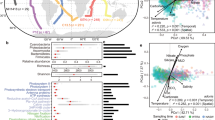Fish dump toxic industrial compounds in Alaskan lakes on their return from the ocean.
Abstract
Pollutants are widely distributed by the atmosphere and the oceans1. Contaminants can also be transported by salmon and amplified through the food chain. Here we show that groups of migrating sockeye salmon (Oncorhynchus nerka) can act as bulk-transport vectors of persistent industrial pollutants known as polychlorinated biphenyls (PCBs), which they assimilate from the ocean and then convey over vast distances back to their natal spawning lakes. After spawning, the fish die in their thousands — delivering their toxic cargo to the lake sediment and increasing its PCB content by more than sevenfold when the density of returning salmon is high.
This is a preview of subscription content, access via your institution
Access options
Subscribe to this journal
Receive 51 print issues and online access
$199.00 per year
only $3.90 per issue
Buy this article
- Purchase on Springer Link
- Instant access to full article PDF
Prices may be subject to local taxes which are calculated during checkout


Similar content being viewed by others
References
Macdonald, R.W. et al. Sci. Total Environ. 254, 93–234 (2000).
Finney, B. P., Gregory-Eaves, I., Sweetman, J., Douglas, M. S. & Smol, J. P. Science 290, 795–799 (2000).
Naiman, R. J. et al. Ecosystems 5, 399–417 (2002).
Burgner, R. L. in Pacific Salmon Life Histories (eds Groot, C. & Margolis, L.) 1–117 (UBC, Vancouver, 1991).
Iwata, H. et al. Environ. Sci. Technol. 27, 1080–1098 (1993).
Indian and Northern Affairs Canadian Arctic Contaminant Assessment Report: Sources, Occurrence, Trends and Pathways in the Physical Environment (Can. Ministry Pub. Works Govt Serv., Ottawa, 2003).
Ewald, G. et al. Arctic 51, 40–47 (1998).
Blais, J. M. et al. Environ. Toxicol. Chem. 22, 126–133 (2003).
Muir, D. C. G. et al. Environ. Sci. Technol. 30, 3609–3617 (1996).
Arkoosh, M. R. et al. J. Aquat. Anim. Health 10, 182–190 (1998).
Author information
Authors and Affiliations
Corresponding author
Ethics declarations
Competing interests
The authors declare no competing financial interests.
Rights and permissions
About this article
Cite this article
Krümmel, E., Macdonald, R., Kimpe, L. et al. Delivery of pollutants by spawning salmon. Nature 425, 255–256 (2003). https://doi.org/10.1038/425255a
Issue Date:
DOI: https://doi.org/10.1038/425255a
This article is cited by
-
Contaminant exposure as an additional stressor to bats affected by white-nose syndrome: current evidence and knowledge gaps
Ecotoxicology (2022)
-
Tissue toxicants and prespawn mortality in Willamette River Chinook salmon
Environmental Biology of Fishes (2020)
-
Comparison of Toxicities of Metal Pyrithiones Including Their Degradation Compounds and Organotin Antifouling Biocides to the Japanese Killifish Oryzias latipes
Archives of Environmental Contamination and Toxicology (2017)
-
Arctic and Sub-Arctic shallow lakes in a multiple-stressor world: a paleoecological perspective
Hydrobiologia (2016)
Comments
By submitting a comment you agree to abide by our Terms and Community Guidelines. If you find something abusive or that does not comply with our terms or guidelines please flag it as inappropriate.



